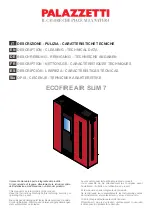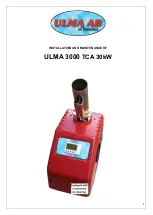
12
13
OPERATION
Lighting and combustion
If, during the first lighting, the stove should emanate smells due to the evaporation of substances
used in the manufacturing, it is sufficient to ventilate the room for a few hours.
Use small and medium-size logs and put them in the fireplace so that the air can penetrate between
them. Place at the base of the stack some lighters (we recommend tablet derived from natural wax).
With the air regulation registers you can regulate the passage of primary and secundary air, necessary
for combustion. While lighting the stove registers shall be totally opened.
This registers are placed in the base of the stove, like in the following drawings:
The use will be as follows:
To light the stove: air registers completely opened
For a medium combustion: air registers half opened
For slow combustion: air registers opened 1/3
These positions can be changed in relation to the chimney flue draft.
ADVICE: do not close the registers completely because by doing so the combustion
would be deprived of the necessary air, giving rise to a choked combustion and to the
growing of soot on the door glass.
N.B. It is also necessary to clean the fireplace area immediately behind the door from
the ashes in order to keep the primary air inlet open. The ash found in this area can be
pushed towards the back of the fireplace or removed.
By using dry and seasoned wood for lighting the stove, it is possible to obtain a high flame and to
immediately activate the draft in the chimney.
When the brazier is formed on the fireplace floor, it is possible to insert larger logs (always crossed for
proper oxygenation). When the charge is burned, it will remain a substantial bed of hot embers that
will allow the charge of the fireplace, without having to perform another lighting; in this way, you will
obtain a continuous combustion.
The combustion control through the glass door will avoid repeated openings of the fireplace and the
consequent lowering of its temperature.
For a good yield, it is necessary to always have a good quantity of wood inside the fireplace; without
overfilling it and without pressing its ceiling and its walls (it is always advisable to leave some space
to let the air circulate).
In this way, the air will circulate freely while keeping a “lively” fire and the refractory bricks will not
suffer unecessary trauma.
Secondary air
Primary air
Fireplace door
Area for
primary air inlet
Fig. N.13
Remove the
ashes
Secondary air
Primary air































